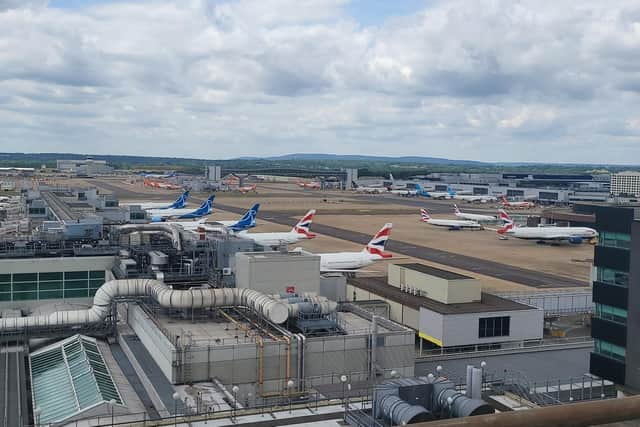Flight delays: UK's best and worst airports for flight delays unveiled with worst offender an average of 27 minutes behind schedule
and live on Freeview channel 276
New analysis has unveiled the worst airports in the UK for flight delays last year. London Gatwick was found to be the worst with departures from the airport an average of almost 27 minutes behind schedule in 2023, according to a Press Association study of Civil Aviation Authority (CAA) data.
Gatwick was badly affected by air traffic control staff shortages across Europe last year. The airport has said in a statement it is "working closely with our airline partners to improve on-time performance".
Advertisement
Hide AdAdvertisement
Hide AdLuton had the second poorest record last year with an average delay of almost 23 minutes. The airport has said the average delay figures are "not helpful" without context and insists the vast majority of its flights left on time.
It claims that most delays were due to factors that were out of its control. In third place was Manchester Airport with an average delay of nearly 22 minutes.


Belfast City had the best performance with a typical delay of 12-and-a-half minutes. Liverpool John Lennon Airport was second best with an average delay of 13 minutes and 24 seconds, while East Midlands was next with an average wait of 15 minutes and 18 seconds.
The average delay for flights across all airports was almost 20 minutes and 42 seconds - down from 23 minutes and 12 seconds in 2022, when the aviation sector struggled to cope with a surge in demand for holidays after Covid. The analysis took into account all scheduled and chartered departures from the 22 commercial UK airports with at least 1,000 outbound flights last year. Cancellations were not included.
Advertisement
Hide AdAdvertisement
Hide AdGatwick said in a statement: "As the most efficient single runway airport in the world, we aim to deliver a seamless passenger experience.The majority of cancellations are caused by poor weather, airspace constraints across Europe and inefficient third party ground operations.
"We are working closely with our airline partners to improve on-time performance. In addition, we have published a six-year capital investment programme setting out significant improvements to develop and enhance infrastructure and facilities to build the resilience of the airport."
Listed below are the UK airports with the worst average flight delay times, starting with the worst and ending with the best.
1: Gatwick (26 minutes and 54 seconds)
2: Luton (22 minutes and 54 seconds)
3: Manchester (21 minutes and 54 seconds)
4: Edinburgh (21 minutes and 48 seconds)
5: Birmingham (21 minutes and 30 seconds)
6: Bristol (20 minutes and 24 seconds)
Joint 6th: Bournemouth (20 minutes and 24 seconds)
8: Heathrow (20 minutes)
9: Newcastle (19 minutes and 48 seconds)
10: Belfast International (19 minutes and 18 seconds)
11: Stansted (19 minutes and six seconds)
12: Aberdeen (17 minutes and 42 seconds)
13: Southampton (17 minutes and six seconds)
14: Leeds Bradford (16 minutes and 54 seconds)
Joint 14th: Cardiff Wales (16 minutes and 54 seconds)
16: Teesside International Airport (16 minutes and 48 seconds)
17: Glasgow (16 minutes and 36 seconds)
18: Exeter (15 minutes and 42 seconds)
19: London City (15 minutes and 36 seconds)
20: East Midlands International (15 minutes and 18 seconds)
21: Liverpool (John Lennon) (13 minutes and 24 seconds)
22: Belfast City (George Best) (12 minutes and 30 seconds)
Comment Guidelines
National World encourages reader discussion on our stories. User feedback, insights and back-and-forth exchanges add a rich layer of context to reporting. Please review our Community Guidelines before commenting.
